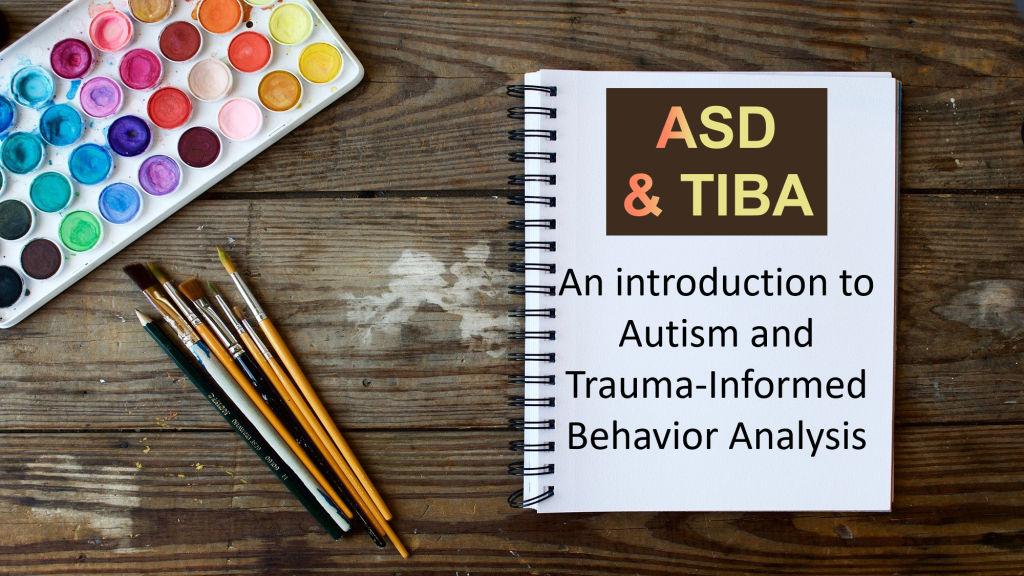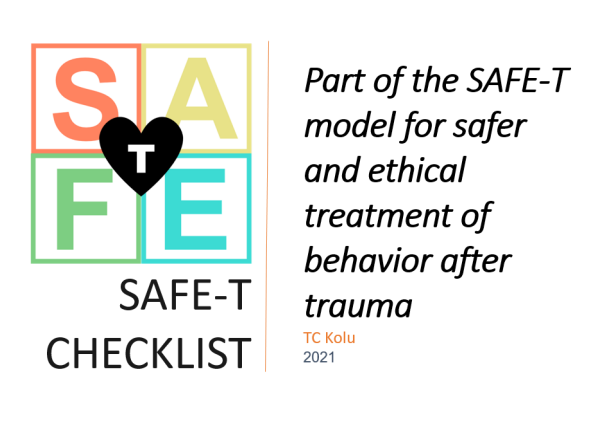This post is part of a series on trauma-informed behavior analysis by Dr. Camille Kolu, Ph.D., BCBA-D.
When treating behavior concerns after trauma, we may find that clients exhibit risks to themselves, risks to their community, and risks to caregivers that should be documented. Why have behavior analysts sometimes turned a blind eye to documenting these risks? Read on to discover some common reasons I found in the field, and ways we can address them.
When it’s too risky to even consider the risks
Our field has adopted a Compliance Code which mentions the need to document risks. As an instructor for courses in a BACB-approved course behavior analysis course sequence, I use a textbook that provides sample templates for documenting and analyzing risks. And as a practitioner, I have found that my analysis or assessment of risk is almost always helpful to a case (as in some situations I’ll describe below), not to mention that it’s quick and simple it is to do.
Despite these facts, most behavior analysts I encounter do not analyze risks in any sort of written format. The behavior analysts around me range from BCBA-Ds to RBTs, and many have expertise and long careers. Why are we averse to documenting risks?
I have been researching the answer to this question for several years, and often the answer is “because I don’t have a good risk assessment”. So I made some and piloted them with different agencies, working through the problems of how to identify, define, document and mitigate the risks related to the populations with whom I work most closely. But at a recent training opportunity I received a different kind of answer, and I think it’s too important to keep to myself.
Some of the BCBA’s I talked to at that event were not documenting risks, they acknowledged, because it was just too risky.
At first it seemed counterintuitive. If I was providing a new document that made it easy to document several options, and the potential risks and benefits of each, wasn’t that inherently reducing the risk? No, it turns out. To many of us, highlighting a risk necessarily imposes some degree of liability.
We’ve faced this challenge before. In pointing out a problem we may become partially responsible for solving it, as some educators have learned the hard way when their schools are upset with them for discussing the observations of a student’s difficulties outside of the official process. This responsibility may carry a financial burden or create an unsolvable problem in a resource-poor area. And some pediatricians I know have mentioned the frustrating dilemma of being given a new depression screen for teens or moms, only to have nowhere to go with the results.
A new ethical responsibility is only as useful as your agency’s process to fulfill that responsibility, and procedures to support the people implementing the new responsibilities.
And in the discussion with the BCBA’s that day about risk documentation, I learned something really interesting. The specific language I used made a huge difference in their willingness of adopting a new procedure.
When I called it a “risk assessment”, BCBA’s were unwilling to adopt my new “assessment”, even if it was backed up by the compliance code and plenty of evidence and anecdotes how it has supported my work.
But when I called it a “risk versus benefit analysis”, they were willing to try.
The difference?
“Risk assessment” is a loaded term that carries legal weight in many contexts.
On the contrary, the other term (“risk versus benefit analysis”) is something that I use daily, and that is simply a process of documenting and analyzing the several different options available, together with their respective potential risks and benefits. It’s called for by the Compliance Code (and discussed by Bailey and Burch in their Ethics text).
According to the Compliance Code, “a risk-benefit analysis is a deliberate evaluation of the potential risks (e.g., limitations, side effects, costs) and benefits (e.g., treatment outcomes, efficiency, savings) associated with a given intervention. A risk-benefit analysis should conclude with a course of action associated with greater benefits than risks.”
The Compliance Code mentions risks in several places. In 2.04b, we are to consider risks of performing conflicting roles (e.g., when we are clarifying third party involvement in services). In 2.09c we are asked to use a risk-benefit analysis as part of our process in deciding between different treatments. And in 4.05, we are asked to work with stakeholders to present the potential risks versus benefits of which procedures we plan to use to implement program objectives. 7.02 asks us to consider risks involved, when there may have been an ethical or legal violation by a peer. And of course, we consider the potential risks and benefits when doing research (9.02).
The Task List does not mention “risk” by name, but alludes to the process when requiring that we are required to be able to state and plan for the possible unwanted effects of reinforcement (C-01), punishment (C-02), or extinction (C-03), as well as behavioral contrast (E-07). Similarly, the Code makes it clear that we are to identify potential for harm with using reinforcement (4.10) and identify obstacles to implementing recommended treatment (4.07).
In my practice, the most efficient way to meet all these objectives and more, is to complete a risk-benefit analysis. I love to include sections on mitigating the risks I do identify, so that the team can make an informed decision about what resources, training, information or support they will need to implement the least risky option.
And a final benefit I’ve heard many stakeholders mention during this process (and typically I do the analysis as an open discussion in which they are involved and brainstorming), is usually stated like this: “I didn’t think we had any other options, but when we approached this with a goal to identify alternatives and the risks and benefits of each, we uncovered several more”.
The risk versus benefit analysis is something I document, add to a treatment plan or employee or client file or IEP, or simply something I share with the team in writing and in person to solidify systems support for my next move. Recently, the following situations were ameliorated by using a transparent risk versus benefit analysis. Outcomes included increasing appropriate funding; securing appropriate medications; identifying appropriate caregivers; funding appropriate training; and improving client satisfaction.
-what kind of residential facility would be most appropriate to move a client to
-whether to discharge a client now or later
-whether to use a cheaper program with fewer resources or a costly one with many
-whether to put a client in a foster home in a potentially risky but supportive situation
-whether to delay an assessment to have an operation
-under what conditions should we discontinue a client who violates our informal no-show policy
-what caregiver to select from several available
-how to appropriately include police contact in a plan in a way that reduced long term risks
-what medication to decrease and when
-whether to put a student in a restrictive school with more behavior support, or a less restrictive placement with more social interaction options
As you can see by the last two, sometimes these decisions are not cut and dry. They depend on the team and family input, and one family may weigh a given outcome more heavily than another. Everyone has a history. To do these analyses in a compassionate and open way is important, and sometimes we don’t agree. To involve high level stakeholders and funders is critical as well.
What are the risks of doing a risk-benefit analysis? Perhaps you’ll highlight more risks than you thought were there; perhaps you’ll have to take some responsibility for the outcome of your recommendations. But what are the risks of avoiding this important process? If you are certified, your responsibility as a behavior analyst “is to all parties affected by behavior-analytic services” (e.g., 2.02). So are there risks of not documenting risks? Sure. You could cause harm or be negligent if there is a known risk you didn’t plan for or discuss with the team. Just like there are risks, there are benefits too. Doing a good risk versus benefit analysis is certainly a helpful cusp for supervisors and behavior analysis leaders to acquire! Many times we have uncovered risks that can be totally avoided next time if we were to act now to change or solidify policies, or use preventative measures in the future. A risk-benefit analysis can be a wonderful contribution to discussing lessons learned.
There are more options to be uncovered. Go out there and find and document them!
Want a resource? Check out the 3rd edition of the Bailey and Burch text Ethics for Behavior Analysts (2016), read more on Cusp Emergence , or check out a risk versus benefit tool (I like to do this on a whiteboard with my teams).
Convinced? Have a question? Drop us an email. And thanks for reading about this important topic. We’d love to see how YOU document and discuss risks!



